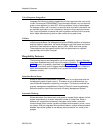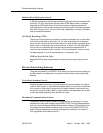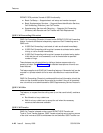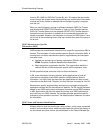
Features
555-230-024
A-42 Issue 5 January 1998
For an incoming call, Early Answer answers the dynamic service-link calls when
the destination endpoint answers, unless Early Answer is specified during routing
or termination processing.
NOTE:
The “destination voice endpoint” might be an outgoing voice trunk if the
destination voice station is forwarded or covered off-premises.
Multimedia Call Handling
Multimedia Call Handling allows you to administer a telephone and a multimedia
endpoint as a multimedia complex. Through this multimedia complex, users can
place voice or video calls using a single number. They can conduct video confer-
ences, and they can forward, cover, hold, or park multimedia calls much as they
would standard voice calls.
The multimedia complex handles calls that conform to the H.320 suite of protocol
standards. These standards allow video-conferencing systems from different
vendors to communicate. An H.320 call can contain voice, video and data. The
capabilities of individual multimedia-endpoint packages may vary.
Multimedia data conferencing (T.120)
via ESM
The data conference is controlled by an adjunct device called an Expansion
Services Module (ESM). The Expansion Services Module is used to terminate
T.120 protocols [including Generalized Conference Call (GCC), a protocol
standard for data conference control] and provide data conference control and
data distribution. The MultiMedia Interface circuit pack, TN787, is used to rate
adapt T.120 data to/from the ESM.
The ESM represents an existing piece of equipment connected to the switch in a
new way. The ESM itself is built on a MAP40 PC platform, connected to the
DEFINITY switch via a PRI link. The link terminates on a new switch-resident PRI
board (TN 2207), which is modified from a standard PRI board with provisions for
cable interconnection to a switch-resident TN787 MMI board. The MMI operates
in the “ESM mode”, and serves to rate-adapt the T.120 data stream from a
service link to the full bandwidth of a PRI B-channel. The cable carries the
adapted data stream over to the PRI link, which carries the information out to the
ESM proper.
The ESM is connected to the switch via an E1/T1 PRI link “front-ended” by an
MMI operating in a special ESM interface mode. The ESM MMI provides rate
adaption between the data subchannel of each endpoint’s H.221 protocol stream
and a PRI B-channel to the ESM.


















